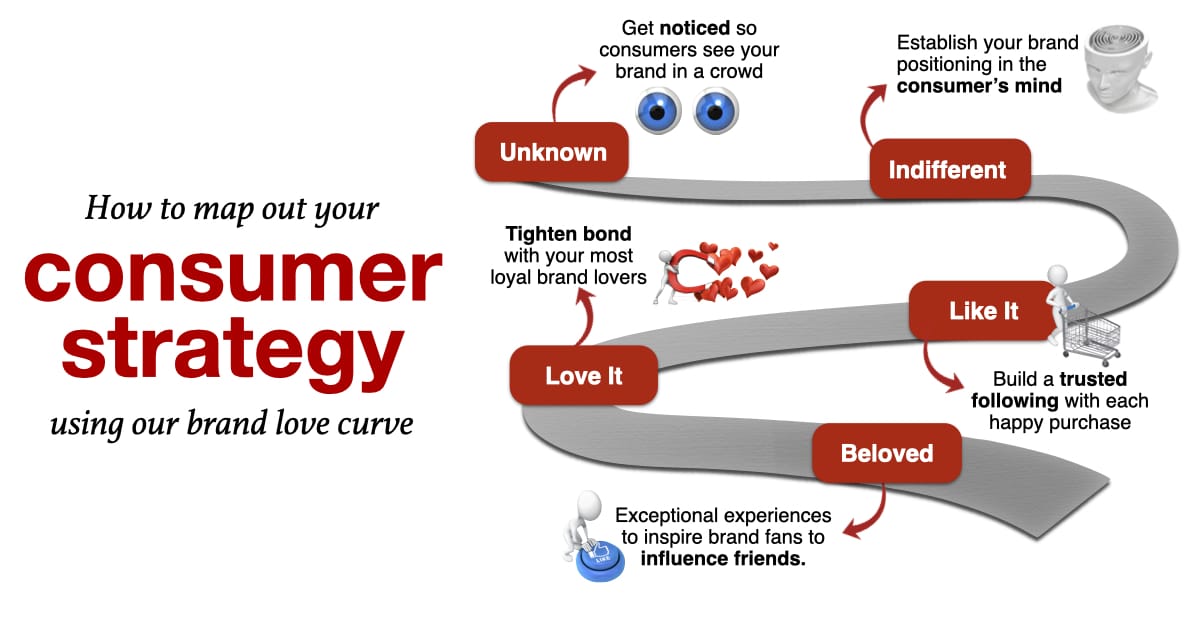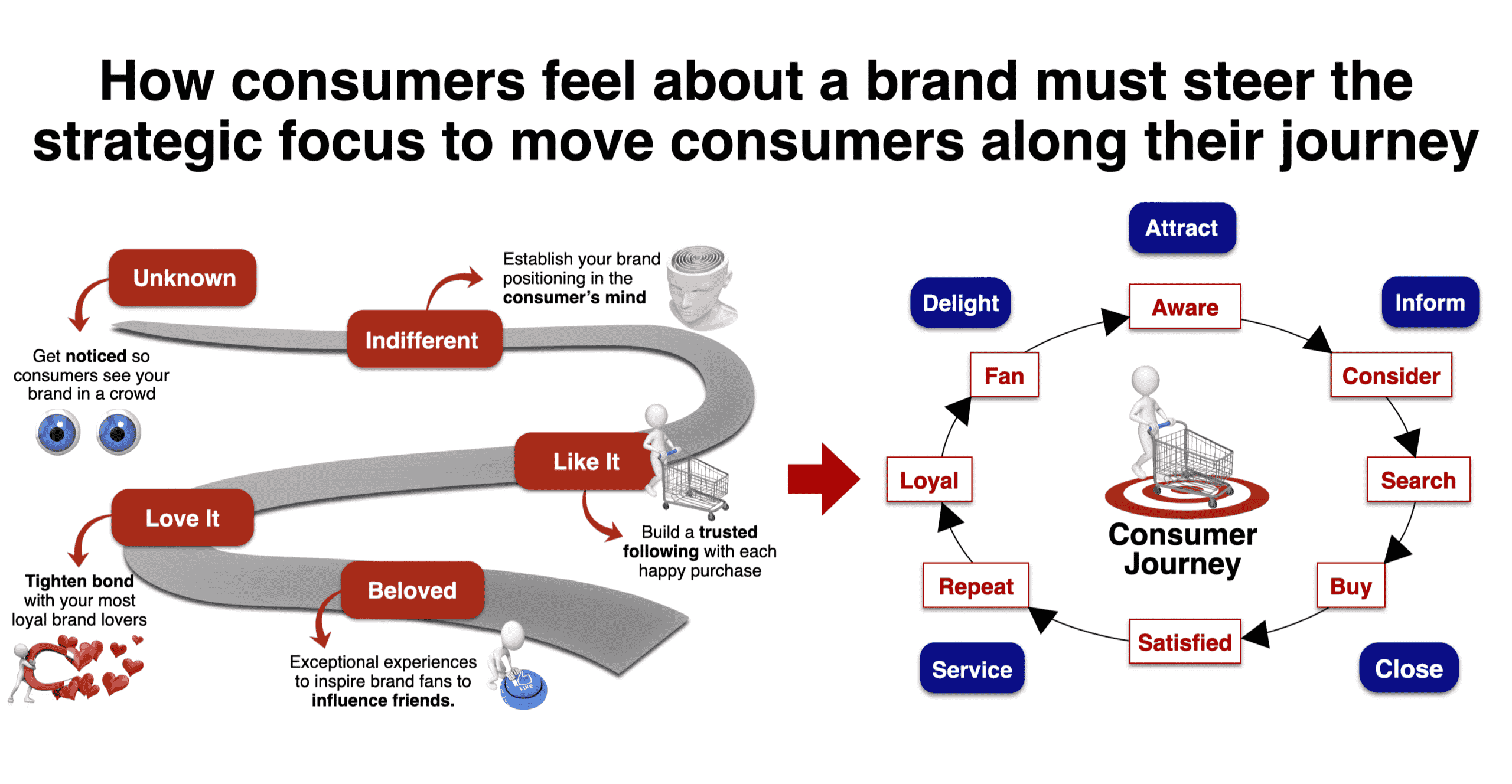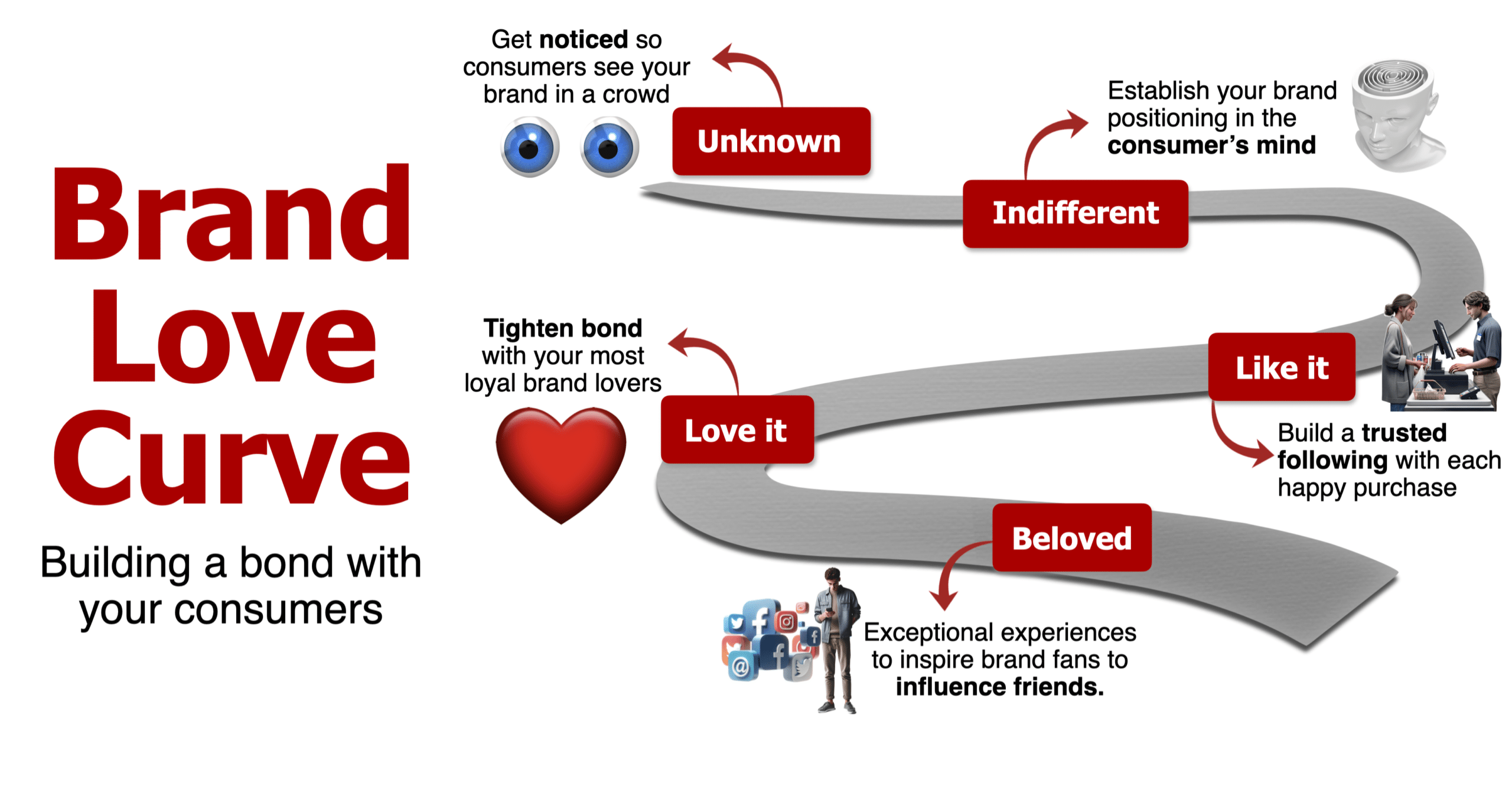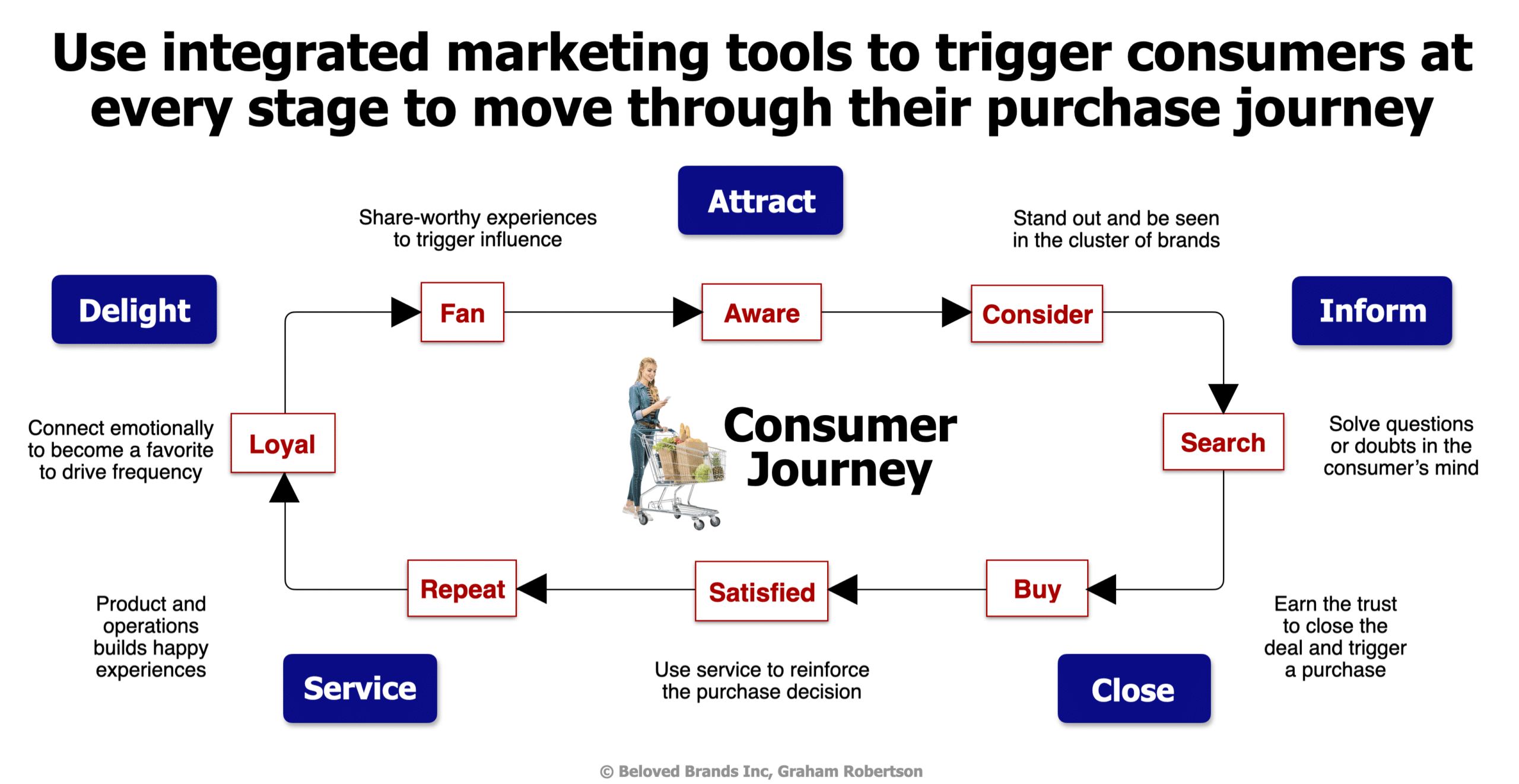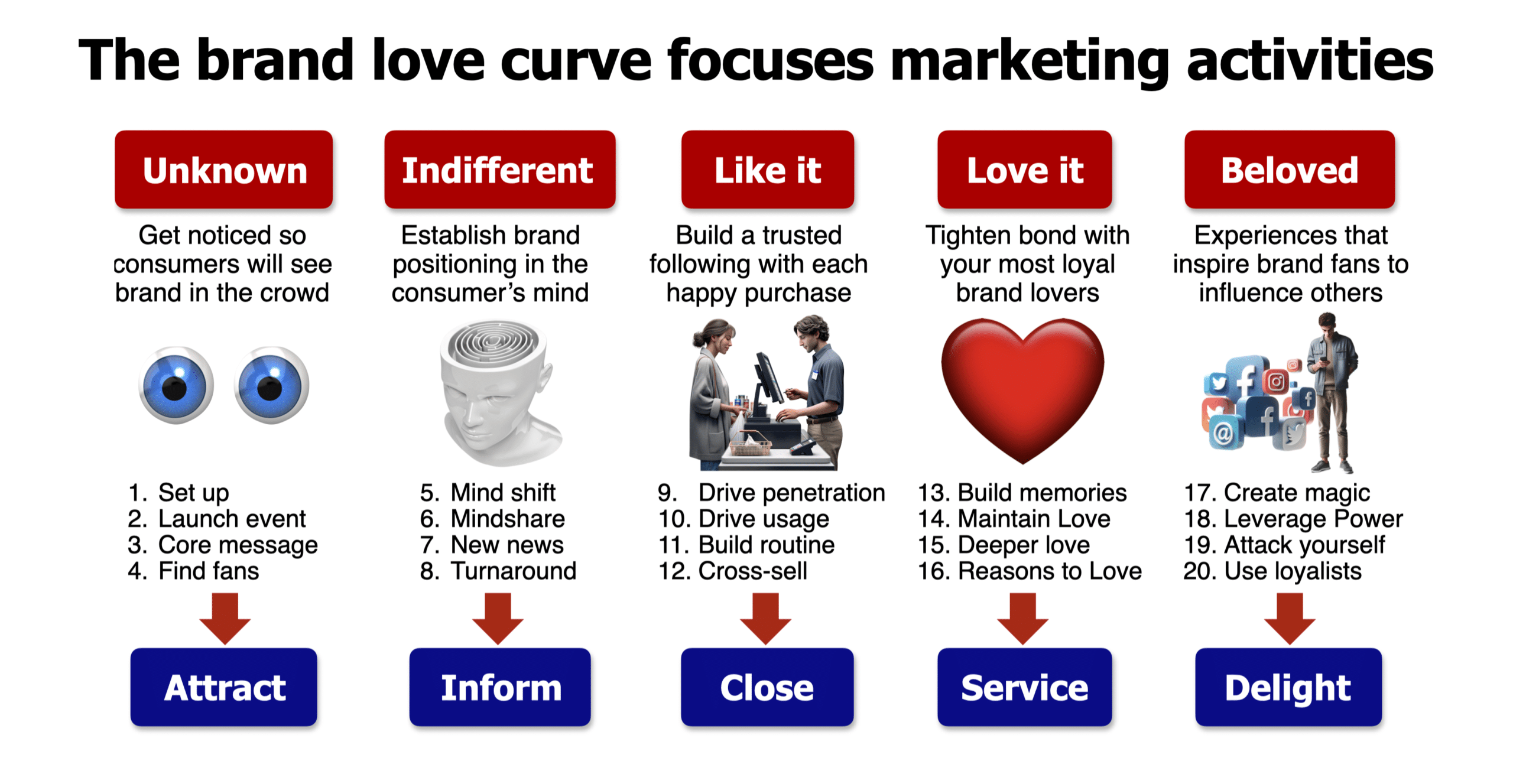Marketers need to use consumer strategy to tighten the bond with consumers, to provide more power and set up the potential to drive added revenue and profits. To show the differences in how consumers feel about a brand as they move through five stages, I created the brand love curve. It defines consumers’ feelings as unknown, indifferent, like it, love it and onto the beloved brand status.
Using consumer strategy to tighten the bond with consumers
For unknown brands, the strategic focus should be to stand out so consumers will notice the brand within a crowded brand world. Then, at the indifferent stage, the strategy must establish the brand in the consumer’s mind so they can see a clear point of difference. And, at the like it stage, the strategy is to separate the brand from the pack, creating happy experiences that build a trusted following.
Next, at the love it stage, the focus shifts to tugging at heartstrings to tighten the bond with the most loyal brand fans. Finally, at the beloved brand stage, the strategic challenge is to create outspoken, loyal brand fans who are willing to whisper to their friends on the brand’s behalf. Our brand love curve helps you find your consumer strategy.
Our Strategic Thinkbox looks at core strength, consumer bond you have, competitive situation you face. I’ve always believed that strategic thinkers see questions before they see solutions. Ever hear someone say, “That’s a good question?”
It means someone just asked an interruptive question, designed to slow everyone’s thinking, so they reflect and plan before they act.
The strategic thinking side of marketing is logical and helps you map out a range of decision trees that intersect, by imagining how events will play out in the future.
With this in mind, I created the Strategic ThinkBox, that asks questions that set up your strategy. We look at four strategic questions to force you to look at:
- Core strength
- Consumer Strategy
- Competitive Strategy
- Business Situation
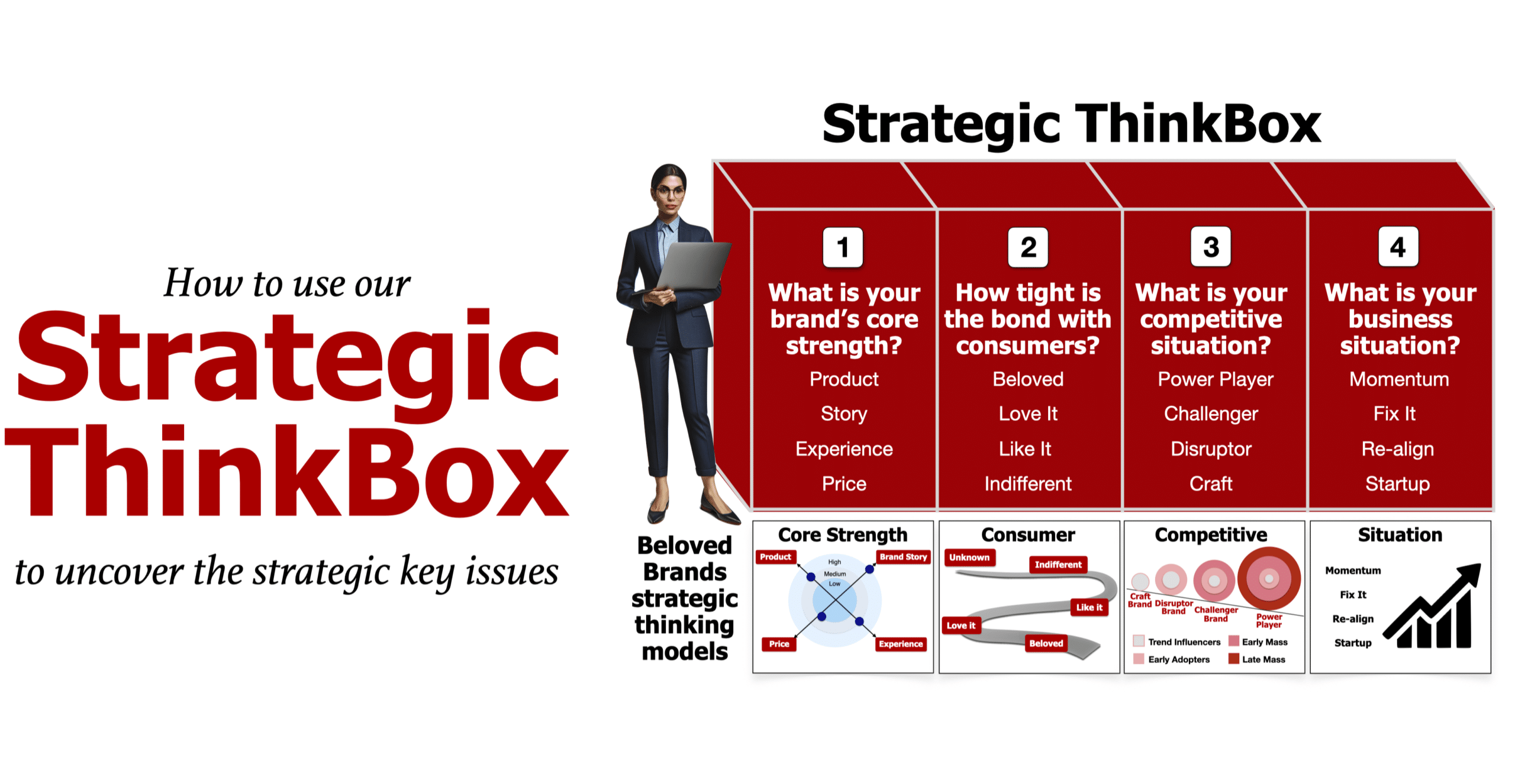
For example, click to zoom in on how our Strategic ThinkBox can frame your strategic thinking.
When I first came up with the brand love curve
I first came up with the idea of a brand love curve when I ran a marketing department with 15 different consumer brands, which exhibited various degrees of success. Honestly, it was hard for me to keep track of where each brand stood. I did not want to apply a one-size-fits-all strategy to brands with dramatically different needs. I could have used some traditional matrix with market share versus category growth rates or stuck with revenue size versus margin rates.
Every day on the job, I noticed brands that had created a stronger bond with their consumer outperformed brands that lacked such a close connection. I started to refer to the high-performance brands as “beloved” because I could see how emotionally engaged consumers were with the brand.
At the other end of the scale, I referred to the inferior performance brands as “indifferent” because consumers did not care about them. They failed to stand for anything in the consumer’s mind; they were not better, different, or cheaper. I could see how these brands were unable to create any connection with their consumers – and they faced massive declines.
Brand love
Everyone treats beloved brands differently
Everything seemed to work better and easier for beloved brands. New product launches were more impactful because the brand’s loyal consumers were automatically curious about what was new. Retailers gave these the beloved brands preferential treatment because they knew their consumers wanted them.
With a beloved brand, retailers knew their consumers would switch stores before they switch brands. Everyone in my organization, from the President to the technician in the lab, cared more about these beloved brands.

No one seemed to care about the indifferent brands. Internal brainstorm sessions produced inspiring ideas on beloved brands, yet people would not even show up for brainstorms on indifferent brands.
Our agencies bragged about the work they did on beloved brands. Even my people were more excited to work on these beloved brands, believing a move to the beloved brand was a big career move while being moved to an indifferent brand was a career death sentence.
These beloved brands had better performance results and better consumer tracking scores on advertising. They saw a stronger return on marketing investment, with a better response to marketing programs, higher growth rates, and higher margins. The overall profitability fuelled further investment into beloved brands.
Consumer strategy
Building a bond with your consumers
Consumer Strategy is about cultivating close relationships with consumers. The best brands of today follow a very similar path to the rituals of a personal courtship.
Through the eyes of consumers, brands start as complete strangers, randomly purchased a few times without much thought. They become acquaintances and, when the brand successfully delivers on expectations, they move into something similar to a trusted friendship.
As the consumer sees a consistent experience and trust, they begin to open up, and the romance begins. The consumer allows their emotions to take over and, without knowing, they start to love the brand. As the brand weaves itself into the best moments of the consumer’s life, the consumer becomes an outspoken fan, an advocate, and one of the many brand lovers who cherish their relationship with the brand.
The brands deliver
As long as the brand delivers on the excitement of the original promise that attracted the consumer on their first encounter, the brand moves into a position where the consumer sees it as a forever love.
To replicate how brand building matches up with the building of a relationship, I created the brand love curve, which outlines how consumers move through five stages: unknown, indifferent, like it, love it, and onto the beloved brand status. This sets up your consumer strategy choices.
The brand love curve
For example, click to zoom in on how our Brand Love Curve drives the consumer strategy.
We created our Brand Love Curve to demonstrate how tightly a brand is connected with their consumers. Brands move along a continuum from unknown to indifferent to Like It, to Love it, and to beloved. The strategy changes at each stage. To illustrate, click to zoom in.
How the brand love curve steers strategy
For new brands, they were completely “unknown” to consumers. Unless there were genuinely compelling messages, consumers would walk past without even looking. To achieve some success, the priority for these brands is to get noticed within the clutter of the market.
At the “indifferent” stage, consumers feel O.K. about the brand, similar to how they usually feel about commodities, like fruit and vegetables. These brands satisfy the consumer’s basic needs.
Consumers will only buy the brand when it is on sale, but switch back to their other brand choice when it is not. Make your brand more than just a commodity. Brands need to be better, different, or cheaper. Otherwise, they will not be around for long, and you waste your investment.
Brands that reach the “like it” stage experience the first sign of business success. Their consumers see the brand as a logical, functional, and smart choice. However, the lack of any emotional connection leaves the purchase up to chance. Consumers will still switch brands randomly. Brands at the like it stage stress the product performance so much they forget to trigger any emotions.
Building a bond
Brands at the “love it” stage start to see more emotionally engaged consumers. The rule of love you must follow: Consumers must love the brand before you can tell consumers you love them. They see the brand as a favorite choice, usually connected to a favorite part of their day. They are loyal and build the brand into a routine. These brands must also find a way to demonstrate their love toward consumers and continue to tighten the bond with their most loyal brand lovers.
The “beloved brand” stage is where the brand becomes iconic, with a core base of brand lovers who cherish and defend the brand. These consumers see the brand as a personal choice, a badge they proudly hold in their hand or wear on their feet. At the beloved stage, the brands must create magical experiences that inspire brand lovers to share with their friends.
In this article, I will show you the consumer strategy game plans for each stage of our brand love curve.
Marketing execution
The brand love curve steers potential activities
The brand love curve should guide strategic and tactical decisions that go into the writing of your annual brand plan. Here are 20 potential brand activities that match up to where your brand sits on the curve and how to move your brand to the next stage. This helps you deliver your consumer strategy.
For example, click to zoom in on how our Brand Love Curve drives the consumer activities to put into your plan.
Unknown brands
All brands start at the unknown stage. Many new brands struggle to break through to reach consumers or build the distribution due to doubting retailers. They face leadership team conflicts, confusion around the value proposition, inconsistent messages to consumers, and everyone in the organization seems to move in different directions. The risk is that you will be seen as a product—not yet a brand idea.
Too often, companies at this early stage fixate more on selling with desperation to anyone who wants to buy. Sure, the cash flow helps. However, when the consumer sees the brand as a commodity, the product has no real differentiation from competitors.
This consumer strategy will make it hard to command a price premium or gain any efficiency. Substantial investment is needed to establish both brand awareness and broad distribution. The unknown brands need to stand out in the crowd.
A three-point game plan for unknown brands:
- First, create a brand idea that expresses your consumer benefit and build everything around that idea, both internally and externally
- Next, focus your limited resources against a focused target, positioning, strategies, and activities.
- Then, passionately express your brand purpose as a rallying point, both internally and externally.
Consumer strategy action plan for unknown brands:
- Brand set-up: To start, establish production, brand promise, advertising, public relations, consumer experience, distribution, and manage the purchase moments.
- Launch event: Build hype and desire to gain attention and awareness with consumers to help hit minimum desired sales levels with channels.
- Build a core message: Amplify brand idea and niche consumer benefit to a core audience to establish a consumer reputation.
- Find early lovers: Most importantly, use your marketing plan to find a small base of early adopters to drive trial among those who are already motivated by what you do. Use their energy to turn them into brand fans who can influence others.
Indifferent brands
Indifferent brands act like commodities. They are usually too product-focused and not yet able to find a way to separate the brand from competitors. These brands suffer from very skinny marketing funnels with low awareness at the top of the funnel, with low purchase rates, low repeat scores, and low brand loyalty scores.
These brands struggle to gain new users or drive frequency. Without a brand idea or unique positioning, the advertising suffers from poor tracking scores, and the innovation shows little payback. Lower payback makes it hard to justify marketing investment in advertising, innovation, or in-store.
Indifferent brands rely on price promotions to drive volume, resulting in a margin squeeze. They struggle to achieve the economies of scale needed to drive down the variable cost of goods. They have no power with retailers, so they are unable to get their fair share of shelf space, display, or price promotions. Private label brands threaten their sales levels.
The consumer strategy for indifferent brands focuses on establishing the brand positioning and, in turn, the reputation in a consumer’s mind.
A three-point game plan for indifferent brands:
- First, focus your brand’s limited resources on proving your brand has a point of difference in the consumer’s mind.
- Then, create a brand idea to establish your brand’s uniqueness to stand out in the cluttered market.
- Finally, put more passion, emotion, and risk into your work.
Consumer strategy action plan for indifferent brands:
- Mind shift: Drive a new brand positioning or reinforce current positioning to change your reputation.
- Mindshare: Draw more attention than competitors by being better or different.
- New news: Launch breakthrough innovation to enter the consumer’s mind.
- Turnaround: Focus energy on gaps or leaks in your brand’s execution. Use the fix to shift minds.
Like it brands
Brands at the like it stage have established a degree of success in the market, and they have created a rational brand positioning with consumers.
However, they lack the emotional connection to build a bond with consumers. They make gains during heavy marketing support periods but fall back down during the non-support periods. These brands appear content to hold onto their share and grow at the rate of the category.
These brands have awareness but they lose out to competitors as the consumer moves to the purchase stage. As a result, they usually require a higher promotional trade spend to close the sale, which cuts into profit margins.
A vital consumer tracking score to watch is “made the brand seem different,” which will help separate your brand from the pack. The consumer strategy forces to the brand to layer in the emotional benefits and focus on creating a stronger following with each happy purchase.
A three-point game plan for brands at the like it stage:
- First, focus resources to build a more significant following with happy purchases.
- Then, leverage the brand idea to start making an emotional connection to build a following.
- Next, increase consumer engagement by adding more passion to your brand execution.
Consumer strategy action plan for brands at the like it stage:
- Drive penetration: Persuade new consumers to try the brand.
- Drive usage: Get happy consumers to use more or use it differently.
- Build routine: Get happy consumers to build a routine around the brand.
- Cross-sell: Get happy consumers to use your brand’s other products or services.
Love it brands
Brands at the love it stage start to see a higher emotional connection with a base of brand fans. These brands also start to gain a stronger usage frequency, as the brand becomes a more significant part of the consumer’s life routines.
With strong consumer tracking results, the brand can leverage more efficient marketing spend. You will notice loyal consumers are highly responsive to advertising and innovation. This thinking makes the marketing spend much more efficient, opening up a pathway to higher profits.
These brands should be able to leverage their power with retailers and influencers. Even in a competitive market, these brands should be able to gain share and widen their leadership stance. With high net promoter scores, they should be able to leverage word-of-mouth or social media recommendations, and positive online brand reviews (Yelp or Trip Advisor) to influence new users.
The consumer strategy for brands at the love it stage must look for unique ways to reward consumers and further tighten their bond with their most loyal brand lovers.
The three-point game plan for brands at the love it stage:
- First, find ways to tug at the heartstrings to help build a community of brand fans.
- Next, shift to the creation of consumer experiences that turn purchases into routines and rituals.
- Then, turn the love for your work into a bit of magic for the consumer.
Consumer strategy action plan for brands at the love it stage:
- Build memories: Create consumer experiences that link the brand with life moments.
- Maintain love: Reinforce the brand strengths with your core base of brand fans.
- Deeper love: Match the passion of your consumers to drive consolidation and get these consumers to use your brand across a broader degree of uses.
- Reasons to love: Reinforce brand messages to your most loyal users.
Beloved brands
Brands at the beloved stage are the iconic leaders in their category. These brands have an extremely healthy and robust brand funnel with likely near-perfect brand awareness (over 95%), high conversion to purchase, strong repeat, and very high loyalty scores. These brands have achieved good penetration and purchase frequency scores.
Tracking results show an immediate reaction to new marketing programs with high brand link scores on advertising and high trial on innovation. They have a dominant share position at least within a specific segment. They have the power to take a dominant stance in the marketplace, to squeeze out smaller brands, and to reduce the influence of other competitors.
These brands have strong net promoter scores and have cultivated a community of outspoken brand fans. They can use their power with retailers to gain preferential shelf space and drive traffic. The company should manage the brand as an asset. The consumer strategy should work to create magical experiences that will inspire brand fans to talk about them and influence others.
A three-point game plan for brands at the beloved stage:
- To start, focus on maintaining the love the brand has created with core brand fans.
- Next, find ways to consistently challenge and perfect the consumer experience.
- Then, broaden the offering and selectively broaden your audience. Be careful.
Consumer strategy action plan for brands at the beloved stage:
- Create magic: Continue to surprise and delight your brand lovers.
- Leverage power: Drive growth and profit from your brand’s source of power.
- Attack yourself: Continue to assess and close leaks to improve before competitors attack.
- Use loyalists: Leverage brand lovers to whisper with influence with their network.
As a summary, our brand love curve helps shift your focus and communication at each stage. At the unknown stage, use mass media to stand out. Next, at the indifferent stage, adding search can help establish what makes your brand different. At the like it stage, emphasize the customer experience to gain trust. Then, as you move to love it, use emotional messages to build a bond with your most loyal consumers. Finally, at the beloved stage, try to create share-worthy experiences that get loyal fans to influence their friends. To illustrate, click to zoom in.


